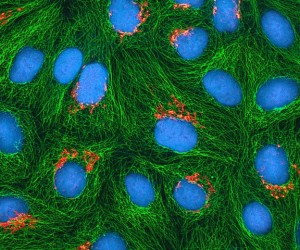
Multiphoton fluorescence image of cultured HeLa cells. Courtesy of the National Institutes for Health
The Polio Vaccine. Chemotherapy. Genetic mapping.
We owe these and countless other scientific innovations to Henrietta Lacks, a poor tobacco farmer from Virginia whose tumor cells were harvested unbeknownst to her while she was a cancer patient at Johns Hopkins University in 1951. This week, for the first time, an NIH committee comprising scientists and members of the Lacks family officially approved scientific use of the cells– fighting decades of non-consensual, unethical appropriation of the cells by the scientific community.
At a time when no scientist had been able to keep human cells alive in culture, Henrietta’s cells, known in the scientific community as “HeLa cells,” could reproduce indefinitely. The miraculous cells— which multiplied at unprecedented rates, reproducing an entire generation every 24 hours— provided a fundamental tool for biology, genetics and medical research, eventually paving the way for treatments for herpes, leukemia, influenza, Parkinson’s and other diseases.
But while Lacks’ cells were being packaged and shipped across the universe (HeLa cells were even sent into space to discover what happened to human cells under zero-gravity), her family remained ignorant of their existence, and, in many ways, misled by a series of doctors and scientists who wanted to use the cells to further research. It was not until 1973 that the family discovered part of Henrietta lived on, only to learn that their mother had been completely dehumanized and lost to the story of “HeLa.”
The Lacks’ 30-year struggle to learn about Henrietta and reclaim their rights to her genetic material is the subject of Rebecca Skloot’s The Immortal Life of Henrietta Lacks. ?The book exposed a series of important ethical issues at play: Should human tissue be used for scientific research? What are the rights of a research subject? What is informed consent (for example, Henrietta had no idea her cells were being harvested for research)? Do you own your own body, or the parts of your body?
The story also raised questions about the greater good. Did the scientific progress made possible by Lacks’ cells justify the duplicity with which their existence was hidden from the Lacks family?
The committee, called the HeLa Genome Data Access Working Group, was the result of intensive negotiations between Francis Collins, director of the NIH, and the Lacks family and is an important step to repair damages to the Lacks family from years of duplicity. In addition to obtaining permission, all future publications that use HeLa data must include the following:
Henrietta Lacks, and the HeLa cell line that was established from her tumor cells without her knowledge or consent in 1951, have made significant contributions to scientific progress and advances in human health. We are grateful to Henrietta Lacks, now deceased, and to her surviving family members for their contributions to biomedical research.
Hopefully, this marks the beginning of a new protocol and trajectory for scientific research– one that is thoughtful of human interest and consequences, mindful to context, and obedient to ethical frameworks for consent.
Like this:
Like Loading...